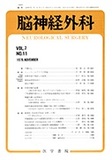Japanese
English
- 有料閲覧
- Abstract 文献概要
- 1ページ目 Look Inside
I.緒言
重症頭部外傷症例の社会復帰に際して,運動麻痺や失語症などがその阻害因子となり得ることは論をまたないが,一見正常人と変らぬ神経活動を有すると思われるまで回復しながら,なお社会復帰が長期にわたり遅れている症例が少なからず認められる.その際にみられる症候は,非積極性,注意散漫,易刺激性など比較的軽微な精神症状が主体となっており,それが器質的脳損傷に由来するものか否か判定に苦慮する場合も少なくない12,25,31,44,45).このような症状は従来外傷後の神経症との関係において論ぜられてきたが,明確な病巣性精神症状を示す場合は別として18,32,33),器質的脳損傷に基づくと考えられる上記のごとき軽微な精神症状の病態に関する記述は少なかった.その主要な原因は,第一に,器質的脳損傷による症状に加えて,年齢,受傷前の職業の特性,病前性格,社会的地位,長期の病悩期間による非特異的反応,さらに外傷神経症,背景反応,詐病,外傷性頸部症候群の合併など,複雑な因子が重なっている場合があること19,25,29,31).第二に,上記のごとき不定の症候を定量的に把握する手段が確立していないこと12,13,23),この二点に求められる.
CNVs were studied in 48 subjects with closed head injury followed by posttraumatic amnesia over than 7 days. Electrical motor-threshold stimulation of the median nerve or subjectively painful stimulation of the fingertip was used for imperative stimulus. An amplitude of CNV and its enhancement by painful imperative stimulus were measured and compared with those obtained from 34 normal subjects.
In subacute stage within 3 months after the head injury, correlation between CNV abnormalities and an existence of some noticeable psychiatric disorders was found.

Copyright © 1979, Igaku-Shoin Ltd. All rights reserved.


